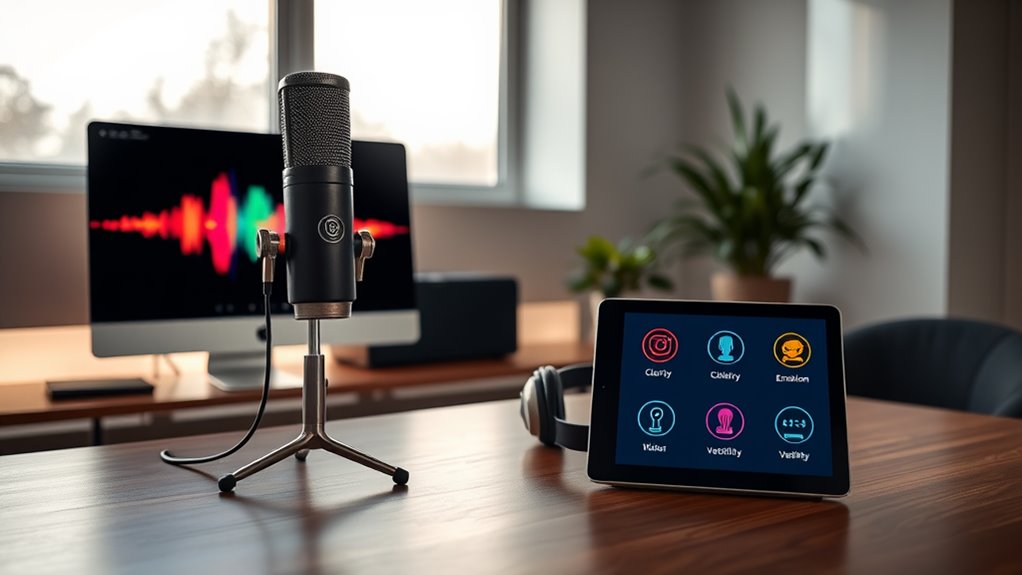Have you ever wondered how OpenAI’s Text to Speech voice achieves such a human-like quality? This technology employs sophisticated neural networks that can produce nuanced speech, but it’s not without its challenges. Understanding both its strengths and limitations can help you better utilize this tool. What else should you consider to make the most of this innovative solution?
Key Takeaways
- OpenAI’s Text to Speech technology generates natural-sounding speech with nuanced intonations for a human-like voice experience.
- It supports multiple languages and offers various voice options to accommodate diverse user preferences and contexts.
- Users can adjust speech rates for a personalized listening experience, enhancing accessibility for individuals with visual impairments or reading difficulties.
- The technology is ideal for content creation, improving engagement in podcasts, audiobooks, and voice interactions in chatbots.
- Limitations include challenges with sarcasm, emotional tone, and regional accents, requiring careful text preparation for optimal output.
Key Features of OpenAI Text to Speech Technology

When you explore OpenAI’s Text to Speech technology, you’ll quickly notice its impressive ability to generate natural-sounding speech. One key feature is its advanced neural network, which allows for nuanced intonations and expressions, making the voice sound more human-like. You’ll also appreciate the variety of voices available, catering to different preferences and contexts. The technology supports multiple languages, broadening its accessibility for users worldwide. Additionally, it offers adjustable speech rates, so you can customize the listening experience to your liking. Robust training data guarantees the system understands context and can produce accurate pronunciations. Overall, these features work together to create a seamless and engaging auditory experience that feels incredibly lifelike. Furthermore, vMixvoice’s support for over 130 languages enhances its usability across diverse user groups.
Applications and Use Cases
The impressive capabilities of OpenAI’s Text to Speech technology open the door to a wide range of applications and use cases. You can leverage this technology to enhance user experiences across various fields.
- Accessibility Tools: Help those with visual impairments or reading difficulties by converting text into spoken words, making content more available.
- Content Creation: Streamline the process of creating podcasts or audiobooks, allowing you to reach audiences who prefer listening over reading.
- Customer Support: Implement voice interactions in chatbots, providing a more engaging and human-like experience for users seeking assistance.
These applications not only improve communication but also foster inclusivity, showcasing the versatility of OpenAI’s Text to Speech technology.
Integration With Existing Platforms

Integrating OpenAI’s Text to Speech technology with existing platforms can considerably enhance user engagement and accessibility. By incorporating this powerful tool into apps, websites, or services, you can provide a more immersive experience for users. Imagine how much easier it’ll be for visually impaired users to access content or for busy individuals to consume articles while multitasking.
Many platforms, like e-learning systems or customer support tools, can greatly benefit from this integration. It allows for dynamic interactions, making your platform not only more inclusive but also more appealing. Plus, it can save time and resources by automating content delivery. Ultimately, integrating this technology can transform how users interact with your platform, making it more user-friendly and efficient.
Best Practices for Optimal Results
To maximize the benefits of OpenAI’s Text to Speech technology, following best practices is key. By implementing these strategies, you’ll enhance the quality and effectiveness of your audio output.
- Choose clear, concise text: Keep your content straightforward to guarantee the voice synthesizer interprets it correctly.
- Adjust speech speed: Experiment with different speeds to find the pace that feels natural for your audience.
- Select the right voice: Depending on your content’s tone, pick a voice that resonates with your target listeners and matches the context.
Understanding Limitations and Challenges

While OpenAI’s Text to Speech technology offers impressive capabilities, it’s important to recognize its limitations and challenges. You might find that the voice can struggle with nuances like sarcasm or emotional tone, which may lead to less engaging outputs. Additionally, the technology’s understanding of context isn’t perfect, sometimes resulting in mispronunciations or awkward phrasing. It’s also worth noting that the voice may not fully capture regional accents or dialects, limiting its effectiveness for diverse audiences. Moreover, if you’re looking for personalized voices, you might be disappointed, as customization options are limited. Finally, keep in mind that heavy reliance on TTS can hinder the development of essential communication skills, so balance its use with traditional methods.
